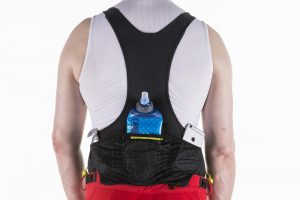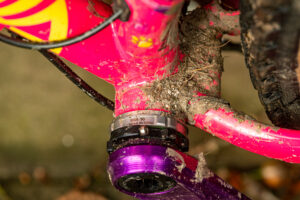OneUp's latest E-Bar is drilled to accept control wires, with a channel underneath the grip that ensures they are kept out of sight. It's carbon and claims to improve comfort without compromising on control. We put it to the test against out reference point carbon handlebars.
OneUp Carbon E-Bar handlebar review
OneUp components likes to do things differently and add value to everything it makes. The Squamish-based brand is not a fan of following the herd. When it comes to handlebars, its number one goal was to improve comfort without compromising on control. Nothing new about that, I hear you say. And you’d be right, as countless brands claim to offer a degree of compliance and comfort with their bars, something you’ll no doubt read backed up by reviews, including our own. Some even go as far as making it their USP, such as Spank, with its Vibracore bar, and the wild-looking, elastomer-damped Fasst Flexx.
So what’s special about the OneUp Carbon E-Bar? To begin with, the E-Bar is drilled to accept control wires, with a channel underneath the grip that ensures they are kept out of sight. This is useful if you have a Shimano-equipped bike, where a wire goes from the remote control unit into the display next to the stem, but it’s not something I used on the Specialized Turbo Levo I installed the bar on. If you don’t have a Shimano-equipped e-bike, or an e-bike at all, OneUp also makes a standard Carbon bar without the drillings/grooves. This is also available in an alternative 20mm rise and it’s about 10g lighter, although the price is the same.

The OneUp Carbon E-bar has routing for control wires
In terms of tech specs, the 35mm diameter E-Bar gets a 35mm rise with an 8º backsweep and 5º upsweep. Instead of eye-balling the bar rotation to get the sweep set up, OneUp provides markings on the bar according to your bike’s head angle. These line up with a dot on the brand’s stem. Obviously you don’t need to use the recommended settings, but it’s a useful starting point and also gives you a reference to work from if you start playing with the roll of the bar to tune the reach or your weight balance. I’d like to see the markings themselves made a bit easier to read.
It’s 800mm wide as standard but I cut my test bar down to 780mm. There are cut marks at 5mm intervals to aid any trimming, and if you like a really narrow bar, it’s worth pointing out that the OneUp is limited to a minimum width of 740mm.
OneUp states that its Carbon handlebar offers 21% more vertical compliance on average compared to the best handlebars on the market, along with a 28% increase in steering stiffness. Bold claims indeed, and it says it has achieved these impressive results by ovalizing the central area around the rise. So does it work?

Use the head angle markings as a starting point for bar rotation
If you’d have asked me that question on my first ride with the OneUp bar I would have given a cautious thumbs up. Sure, it seemed reasonably comfortable, and I could visibly make it flex if I put all my weight into the bar when stationary, but it didn’t feel dramatically different to the Truvativ Descendant Carbon bar I’d taken off. Or so I thought.
What really highlighted the difference was riding the OneUp bar back-to-back with a regular carbon bar. Once again I selected the Truvativ Descendant Carbon bar. It also has a 35mm clamp, 25mm rise and it was cut to the same 780mm width as the OneUp.

Paired with OneUp’s stem, it’s easy to get your bar centred
To control the variables as much as possible, I rode the same track, on the same bike, and only changed the handlebar. I did two runs on the OneUp, then one on the Truvativ, then a further two on the OneUp. There was noticeably more deflection with the Truvativ bar when hitting roots head on, and the front end tended to ricochet away from these impacts. I had to hold on tighter and I could feel feedback from the trail as much through my hands as my feet. On the OneUp bar the trail was calmer, and less spiky. I could relax my hands and the bike wasn’t getting deflected off line as much. While my feet continued to feel feedback from the trail, it was muted through my hands. Truvativ’s bar is noticeably more direct, but OneUp’s bar is still adequately accurate given how much more compliant it is. The steering doesn’t feel vague – you just point it and it goes – but there is a slight loss of precision.
So, OneUp’s bar genuinely delivers on its promise of more comfort and compliance. It’s a calmer, less hectic cockpit environment, that lets you relax your grip on the reins through the roughest chunder.
Verdict
The only problem with this OneUp Carbon bar is you quickly get used to the advantage it brings. You almost need to swap back to a regular bar every few weeks to stop yourself taking it for granted. £150 is top end for a carbon handlebar, but the OneUp Carbon E-Bar actually delivers an advantage that goes beyond saving a few grams.
















